
Previously, he worked as an engineer in the private sector, designing water, stormwater, and wastewater systems. He holds a bachelor’s degree in Civil Engineering from North Carolina State University and a Master’s degree in Civil and Environmental Engineering from M.I.T. In Jeff’s current post as Director of Water Technologies for WE&RF, he runs the Leaders Innovation Forum for Technology (LIFT) program, which aims to accelerate innovation into practice in the water quality industry.
*Note: In May 2016, the Water Environment Research Foundation merged with the WateReuse Research Foundation. According to Jeff, the merger reflects a move toward a more holistic approach to water management. To avoid confusion, Leaf Litter uses the acronym WE&RF throughout.
Can you briefly describe your role at WE&RF, and the ways in which the organization has supported and continues to support the advancement of decentralized wastewater treatment?
Currently, I lead a relatively new program called LIFT which stands for “Leaders Innovation Forum for Technology.” The goal of LIFT is to accelerate water innovation and move new technologies into practice.
Previously, one of the most significant efforts that WE&RF led relative to decentralized systems was the Decentralized Water Resources Collaborative. This was a two-phase, EPA grant-funded research effort. The first phase, which lasted from 1996 to 2003, was led by Washington University in St. Louis, and WERF was on the advisory committee. The second phase, which lasted from 2003-2010, was managed by WERF and I was the program director. Combined, the two phases involved about 80 projects and $16 million in research. All of that information is available at no cost on the web site decentralizedwater.org.
Although the Decentralized Water Resources Collaborative ended in 2010, WE&RF has continued to support decentralized wastewater treatment research through our Sustainable Integrated Water Management (SIWM) program currently led by Program Director, Harry Zhang, and through some of the new decentralized technologies we are working on with LIFT.
What can you tell us about LIFT?
The water sector is relatively conservative and risk averse. There are good reasons for that, because we are dealing with public health and the environment. But at the same time, when public agencies wait 5, 10, or 20 years to adopt a new technology, they are missing out on opportunities to reduce costs, enhance treatment processes, and improve the environment. For innovators, this delay makes the proverbial “valley of death” [crossing from R&D into commercialization] much larger. LIFT is intended to help accelerate the process of moving innovation into practice and to make our sector a more attractive place for capital to flow to help finance new innovations. The LIFT program is for everything from emerging, to pre-commercial, to newly commercialized technologies. It is not for established technologies.
What avenues are you taking to work toward that goal?
We have a three different components. We have a program on technology evaluation which identifies, screens, and evaluates new technologies. We have a people and policy program, which focuses on regulatory and policy barriers to innovation. We are working with the EPA to develop actions to overcome those barriers. The third, which is considered a social component, is an informal forum for R&D managers and others at public agencies who are responsible for the deployment of new technologies. Innovation is really a social process; you learn about new things from your colleagues, friends, and family. About 350 municipal and industrial facility owners participate in this informal forum, which we call the LIFT Working Group. They are all sharing information and collaborating to share the cost and risk of moving innovation into practice.
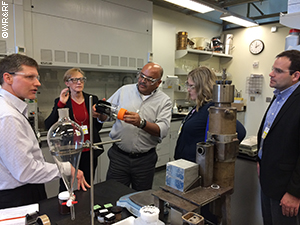
LIFT participants tour lab facilites at Pacific Northwest National Laboratory where a collaborative LIFT project is being conducted
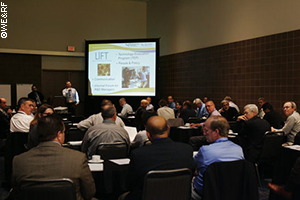
Many of our readers may be interested in learning more about the Working Group or becoming a part of it. How can they do that?
They can contact me and they can take a look at the LIFT page of the WE&RF web site. We have a lot of tools and ways to engage on the web site. For example, if you are a new technology developer, you can submit an application to our technology scan program. This is a free service we provide. The application consists of 10 questions designed to obtain the information that most end users want to know about a new water technology. Once we receive applications, we screen them with volunteer expert panels. Those accepted into the program are invited to give a presentation to our LIFT Working Group, the end users of technology. Then we do some matchmaking to try to form collaborative projects to pilot test those new technologies.
Does LIFT also try to draw innovators to the water management field?
Right now, we have a program to better link utilities with universities. In many areas, universities and utilities operate in silos: universities come up with new solutions and look for problems, and utilities may have problems and are looking for solutions. So we are developing guidance on how to better connect the two.
Sudhir Murthy, Innovations Chief at DC Water and one of the Chairs of our program, tells a story about how he visited a wastewater utility in Beijing, China, and noticed many students there. The students had all kinds of small and large-scale projects going on, and they were collecting data nearly around the clock. They even had some sort of dormitory there. I don’t know that we’re looking to build dormitories at wastewater utilities here in the U.S., but I think there is a real opportunity to better embed students at utilities where they can work on some real world problems.
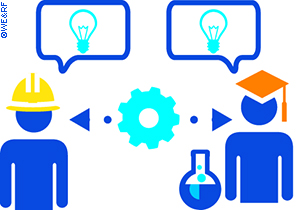
The 80 projects you mentioned earlier, which were initiated under the Decentralized Water Resources Collaborative, fell into three categories: Environmental Science and Engineering, Management, Economics and Policy, and Training and Education. Can you highlight an example from each of those categories and explain how it advanced the practice of decentralized wastewater treatment?
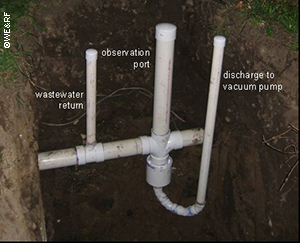
Collection Vessel with Access Ports used by researchers at the Colorado School of Mines
Under the Environmental Science and Engineering category, a project called “Influent Constituent Characteristics of the Modern Waste Stream from Single Sources” was very useful. A lot of the design criteria used for decentralized systems is based on data that was collected a long time ago. Since that initial data was collected, perhaps as far back as the 1970s, things in the household have changed. There are new products on the market with new formulations and chemicals. The way we use water and the different types of fixtures we use has also changed, which might impact flow. This study, which was led by the Colorado School of Mines, had a significant field component. In an effort to gather new information to aid in on site wastewater design and treatment, the researchers gathered data from both the raw wastewater and septic tank effluent from 17 different sites in Colorado, Florida and Minnesota. Thanks to that study, there is now a lot of new data to help with design. Interestingly, they found that water use was 25% lower than in previous studies. I believe that was due in part to water conservation measures such as low flush toilets and low flow fixtures.
We tend to think of decentralized systems as being for mostly rural areas. However, under the Management, Economics, and Policy category, a study was conducted called “When to Consider Distributed Systems in an Urban and Suburban Context”. It included a number of different case studies of these types of applications being used successfully in everywhere from green buildings, independent communities, to utility optimization. They developed a decision-making tool, which is available on line.
Many of the projects in the Training and Education category were led by the Consortium of Institutes for Decentralized Wastewater Treatment (CIDWT), a group of about 17 different universities around the country that work on decentralized wastewater treatment systems research. That group collectively developed a suite of materials, including an installer training program, an O&M service provider training program, a university curriculum on decentralized wastewater management, and a non-credit curriculum for wastewater practitioners. These documents are available under the resources section of the CIDWT website. They also trained thousands of people around the country using these materials. They also developed a glossary of terms, because there is some confusion in the industry over different terms. Those training materials are all available on line.
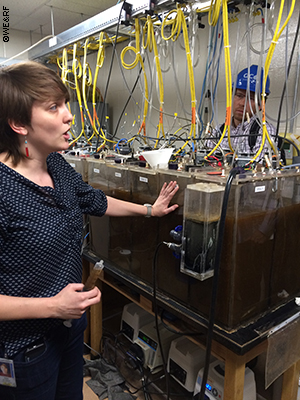
As you mentioned, the Decentralized Water Resources Collaborative program ended in 2010. What current projects related to decentralized WWT does the Foundation have underway that you are most excited about?
Working closely with San Francisco Public Utilities Commission, we recently completed a Blueprint for Onsite Water Systems: A Step-by-Step Guide for Developing a Local Program to Manage Onsite Water Systems (SIWM7W14). It is a very handy guide that provides a sequence of steps for people–primarily those in public agencies in urban environments–to take to inform decision-making on how to scope, structure, and implement decentralized systems.
Another exciting project, which was co-funded by WE&RF but led by the National Water Research Institute (NWRI), is just wrapping up. It involved the convening of an expert panel and the development of a report called “A Risk-Based Framework for the Development of Public Health Guidance for Decentralized Non-Potable Water Systems” (SIWM10C15). The report addresses onsite non-potable water reuse from decentralized wastewater treatment systems, on a building or district (i.e., cluster of buildings) scale, particularly in urban systems, such as in green buildings. The report provides guidance on how to implement these systems in place while protecting public health and safety. The report is just being completed, and will be released in the next few months. There is a free webinar to share the findings on October 12: Creating a Framework for Decentralized Non-potable Water Systems.
WE&RF recently awarded a contract to pioneer research that will advance knowledge of how effective economic conditions can be developed to promote the beneficial use of water from water resource recovery facilities and stormwater facilities. The primary goal of the project, which is called “Economic Pathways and Partners for use of Reclaimed Water and Harvesting Stormwater,” is to develop pathways for Utilities of the Future to utilize reclaimed water and stormwater as a benefit for communities.
Another project your readers may find interesting is “Integrating Water Management with Urban Planning and Design (SIWM5R13).” This research examines the gaps between water managers and urban planners, how a full spectrum of water services can be integrated with urban development, and will provide recommendations to encourage integration. The researchers are interviewing thought leaders in the U.S. and abroad about strategies for integration and recently completed a nationwide survey, as part of a joint-effort with a closely related Water Research Foundation (WRF) project. The survey garnered over 500 responses from water managers and will help to better identify key factors and barriers to integration between the water and planning sectors in regards to One Water solutions.
We also continue to participate in the EPA Decentralized Wastewater Management Memorandum of Understanding (MOU) Partnership. The partnership is a group of 18 organizations working together at the national level to improve decentralized systems performance, such as through promoting Septic Smart Week 2016.
What role do you see decentralized WWT playing in the sustainable water management 50 years from now?
In general, our perception of decentralized systems is undergoing a change. Decentralized systems used to be the redheaded stepchild of the wastewater arena. They were used primarily in rural areas and were often considered a temporary solution until you could get hooked up to a centralized system. But with advances in technologies like remote monitoring as well as basic science, that perception is changing. Now, we are seeing very exciting things with urban and suburban applications, and with the incorporation of decentralized systems into green buildings. Looking forward 50 years, there is a lot of opportunity for cost and energy savings, and for just-in-time installment using modular systems. I think that having a centrally managed network of decentralized systems to ensure proper performance and operation will be key.
Do you think we’ll see that in 50 years?
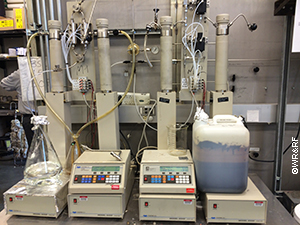
PNNL lab facility where a collaborative LIFT demonstration project is being conducted
It is possible. A lot of it will be driven by economics, but there will be some policy and regulatory hurdles that might need to be smoothed out to allow these types of systems to come on line.
I also think more research needs to be done in terms of determining the most sustainable or cost-effective approaches, and the right scale for what you are trying to achieve. If you are looking at water reuse, certainly it makes sense to treat and reuse water locally. You can save a lot of cost in having to collect wastewater and to distribute treated water over long distances. But there are some advantages to centrally collecting things. For example, if you are looking at energy recovery from organic waste, the argument could made that perhaps that is better done at a centralized facility, like a digester.
Maybe someday, you’ll be able to go to Home Depot and buy a water reuse appliance. We’re not there yet, but who knows where technology and economics will take us in 50 years?
A report put out by the Collaborative in 2010, which was an update to a market study done in 2000, states that market opportunities for decentralized wastewater treatment have not been realized. The report attributes this mostly to ineffective strategies by market leaders and government. What are some examples of these ineffective strategies, and what can we learn from them?
One thing that I wouldn’t say was an ineffective strategy, but a recommendation that has yet to be fully implemented, is the standardization of regulatory approaches across states. This is a huge barrier for the decentralized industry. If you are an innovator trying to get a new technology into practice, you not only have to get approval state by state, but in some cases, county by county. Getting these approvals can be extremely expensive and time-consuming. If you are spending a couple hundred thousand dollars and several years on a demonstration to show that your technology works, how many times can you do that if you are a small technology provider? This is an area that is really critical for us to fix. If we want innovators to move into our sector, we need to make it an attractive place for new capital to flow. Investors are not going to invest in something that is going to take 20 years to generate a return on investment.
There are some things happening that provide hope. States in the Chesapeake Bay region, for example, have started to come together on this issue. They have not come as far as automatic reciprocity, but they have agreed to share data in a common place, and they are coming to agreement on common protocols for testing.
In addition to the fragmentation of regulations by state or county, how much of a barrier to progress is the fragmentation or “siloing” of water infrastructure and policy into categories such as wastewater, potable water, stormwater, recreational water, and ecological water?
The paradigm is starting to shift to a more holistic, “one water” management approach. There are a lot of efficiencies that can be gained by moving out of our silos, taking a step back, and asking, “As a system, what is the best way for this to perform?” Through WE&RF’s Sustainable Integrated Water Management Program, we recently published a report on “Institutional Issues for “One Water” Management (SIWM2T12). This report provides a lot of excellent recommendations on how we can set up our institutions to optimize performance of the system as a whole.
Are there other countries that are further along in that paradigm shift than the U.S. that would be good to look to as models?
Many people point to Singapore, which has a significant water reuse program. They treat wastewater and reuse it to augment their drinking water supply. They call it “new water,” and they have done a great job of getting public buy in and acceptance. Israel, Australia, and more recently, southern California are also places that are further along in that paradigm shift.
What is the most powerful driver toward such a paradigm shift?
Necessity drives a lot of it. For Singapore, it was a national security issue. Singapore was very dependent on water from Malaysia. There were some contentious issues between the country and Singapore wanted to be more self-sufficient. California is in an extreme, five-year drought, so they are looking at all kinds of ways to reuse water. Orange County, for example, is treating wastewater and using it to recharge groundwater.
A local leader, such as a mayor, who has this vision, can really help drive decentralized wastewater treatment forward. Another powerful driver is the value of water. Where you see drought, people are starting to see the true value of water and are seeking to push the limits of this new paradigm.
Are we seeing an increase in projects piloting and showcasing innovative on site wastewater treatment systems? If so, can you share an example that you think is particularly promising and tell us why?
In the LIFT program, we have been developing a national Test Bed Network, which included some decentralized system test bed facilities. One of the best examples out there is the Massachusetts Alternative Septic System Test Center. They have been testing a number of different technologies over a number of years.
In significant hot spots—places where there is a lot of concern about nitrogen impairing the local waters—action is happening. On the East Coast, some of these hot spots include Cape Cod, Long Island, and the Chesapeake Bay region. Some of the federal agencies provide opportunities through Small Business Innovation Research (SBIR) program.
What role do you see for decentralized WWT in light of the regional and national emphasis on resiliency and adaptation to climate change?
There are some who argue that a decentralized systems approach may be more resilient because if a large, centralized system goes down, you affect tens of thousands, if not hundreds of thousands of people at a time. But I think we need more research to fully understand that.
One of the recommended strategies in the market update paper was to develop learning and outreach programs for change agents. Who are the change agents in this movement toward decentralized wastewater treatment?
One example I mentioned earlier is the San Francisco Public Utilities Commission. Paula Kehoe there is a great champion in terms of onsite non-potable reuse and decentralized systems in an urban environment. But our industry really needs more champions, change agents, and innovators to drive us toward more sustainable water resource approaches. The more we can encourage these people and grow the next generation, the better.

